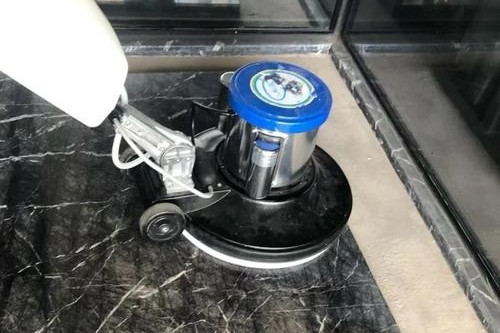
Polishing Techniques for Tarnished Stone
Stone is a popular building material known for its durability, resistance to wear, and beauty. However, over time and with frequent use, stone surfaces can lose their luster and become dull. Fortunately, professional polishing techniques can restore stone to its former glory. In this article, we'll explore the reasons why stone loses its luster and what effective polishing techniques can be used to restore its appearance.
Research on the Causes of Stone Gloss Loss
Understanding the causes of tarnish is essential to effective restoration. The main causes include:
What to wear: Stone surfaces are constantly subject to friction from foot traffic, furniture and vehicles. This constant wear and tear will gradually weaken the surface of the stone, causing it to lose its luster and appear dull.
Stain: Dust, oil and other substances can accumulate on the surface of stone. If not cleaned regularly, these stains can penetrate the stone and cause it to fade and lose its luster.
Chemical reaction: Exposure to certain chemicals, such as acidic or harsh detergents, can cause a chemical reaction that can discolor the gemstone or strip it of its protective layer, resulting in a dull appearance.
Improper maintenance: Regular maintenance, including cleaning and waxing, is essential to maintain the stone's shine. Neglecting these maintenance steps will cause the surface to become damaged and gradually lose its shine.

Tips for Polishing Tarnished Stone
Stone surfaces, whether used indoors or outdoors, are prized for their durability and beauty. However, over time, these surfaces can lose their luster due to wear, stains, chemical reactions, and improper maintenance. Fortunately, hand polishing offers an effective solution to restore the beauty of stone.
Step 1: Clean thoroughly
Before you begin polishing, make sure the stone surface is thoroughly clean. This step is crucial to achieve the best polishing results. Here's how to do it:
Choose the right cleaner: Use a professional stone cleaner or a neutral cleaner that is safe for the stone you are working on. Avoid using acidic or abrasive cleaners as they can further damage the stone.
Use cleaner: Dilute the cleaner according to the manufacturer's instructions and apply it to the stone surface.
Scrub the surface: Use a soft brush or floor brush to gently scrub the surface to remove dust, oil and other stains. Pay special attention to areas with obvious stains or discoloration.
Rinse thoroughly: After scrubbing, rinse the stone surface thoroughly with clean water to remove any remaining detergent and debris.
Dry the surface: Use an absorbent cloth to dry the surface, making sure it is clean and dust-free. This preparation is essential for the subsequent polishing steps.
Step 2: Comprehensive inspection
After the stone surface is cleaned, perform a thorough inspection to assess its condition. This step is critical in determining the appropriate polishing technique and materials. Here are some things to look out for:
Degree of wear: Inspect the surface for signs of wear, such as scratches, dark spots, or uneven areas. Knowing the degree of wear will help you choose the right tools and techniques.
Type of stain: Determine the type of stains present on the stone. Are they oil-based, water-based, or caused by a chemical reaction? Different stains may require specific cleaning or polishing methods.
Stain distribution: Note the location of the stain. This information can help you focus your polishing efforts on the areas most likely to be stained.
Step 3: Choose the right polishing material
1. Diamond grinding disc:
Best for: Hard stones like granite and quartz.
Description: These discs are embedded with diamond particles for efficient grinding and polishing of hard surfaces. They are available in a variety of grits, you can start with coarse grit for heavy wear and then gradually transition to fine grit for a polishing effect.
2. Resin grinding disc:
Best for: Softer stones like marble and limestone.
Description: Resin discs are less aggressive than diamond discs and are ideal for achieving a smooth finish on softer stones. They provide a good balance between polishing and protecting the stone surface.
3. Polishing powder:
Best for: Final polishing of all types of stone.
Description: Polishing powder is usually made of fine abrasives and can be used to achieve a high gloss finish. Polishing powder is usually mixed with water to create a slurry that can be applied to the stone surface.
4. Abrasive pad:
Best for: General polishing tasks on a variety of stones.
Description: These polishing pads come in different textures and grits for a variety of polishing applications. They can be used with a polishing machine or manually, depending on the size of the polishing area.
Choosing the right tools
1. Polishing machine:
Type: Floor polisher, handheld grinder, or orbital sander.
Description: The choice of machine depends on the size of the area you are working on and the type of stone. For large areas, a floor polisher is ideal, while a handheld sander is suitable for smaller or intricate areas.
2. Absorbent cloth:
Best for: Clean and dry stone surfaces.
Instructions: Use a high-quality microfiber cloth to wipe the stone before and after polishing. These cloths are effective in removing dust and residue without scratching the surface.
3. Water source:
Importance: For wet polishing methods, make sure you have a reliable source of water to keep the stone surface cool and minimize dust.
Step 4: Coarse grinding
Rough grinding is the first step in the polishing process and is designed to remove ridges, scratches, and other imperfections from the stone's surface. Here's how to do it effectively:
Materials required: Use a diamond or resin-bonded grinding wheel appropriate for the type of stone you are working on.
Tip: Adjust the sander to the appropriate speed and pressure. Be sure to apply pressure evenly to avoid creating uneven surfaces.
Note: Be careful about the pressure you apply; using too much pressure may damage the gemstone. Start with lower pressure and gradually increase as needed.
Cleaning: After rough grinding, rinse the stone thoroughly with clean water to remove dust and debris. Wipe the surface dry with an absorbent cloth to prepare for the next step.
Step 5: Medium grinding
After the rough grinding, medium grinding is needed to further refine the stone surface. This step helps to obtain a smoother surface.
Materials required: Choose a medium abrasive material appropriate for the type of stone.
Technique: Use the appropriate grinding wheel and adjust the speed to ensure even stress distribution across the entire stone surface.
Cleaning: After medium grinding, rinse again with clean water and wipe dry. This step is essential to help remove residual particles and prepare for subsequent fine grinding.
Step 6: Fine grinding
Fine grinding is a key stage in the polishing process and directly affects the glossiness of the stone surface.
Materials required: Use a fine abrasive material such as a finer diamond or resin disc.
Tip: When fine grinding, be careful to control speed and pressure. The goal is to achieve an even and smooth surface without causing damage.
Cleaning: After fine grinding, rinse the stone thoroughly with clean water and wipe dry with a cloth. This ensures that there is no residue on the surface before polishing.
Step 7: Polishing
After fine grinding, the polishing step is essential to achieve a high-gloss surface.
Materials needed: Use a polishing powder or liquid specifically designed for your stone type.
Tips: Apply the polishing paste evenly on the stone surface. Use a polishing machine to polish, maintaining a constant speed and appropriate pressure to ensure an even polishing effect.
Cleaning: After polishing, rinse the gemstone with clean water and wipe dry. This final cleaning step removes any remaining polish and enhances the gemstone's shine.
Step 8: Maintenance
Once the polishing process is complete, proper maintenance is essential to extend the life of the stone and maintain its shine.
Waxing: Applying a high-quality wax can enhance the gemstone's shine and provide a protective layer against stains and wear.
Protective: Depending on the type of stone and the environment it will be used in, consider using a stone sealer or protector. This will help protect against stains and moisture, extending the life of the stone.
Clean regularly: Create a daily cleaning schedule using a pH-neutral detergent to prevent dirt and stain buildup.
-
Online service
-
Official wechat
account
-
QQ:40933769
-
E-mail:
sales@z-lion.com
Online service
Please feel free to give your inquiry in the form below. We will reply you in 24 hours.

